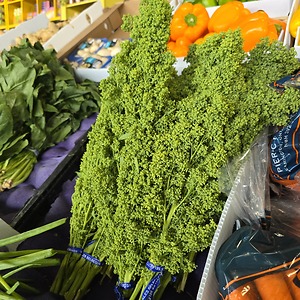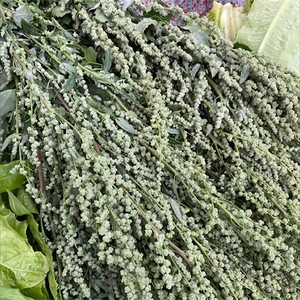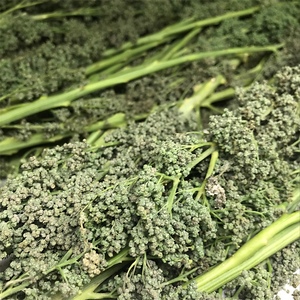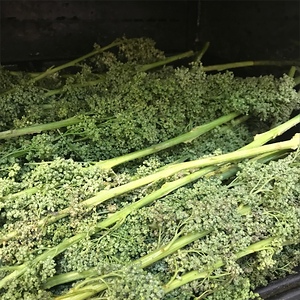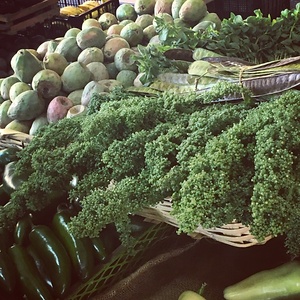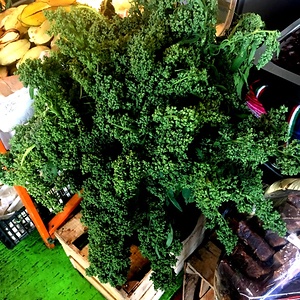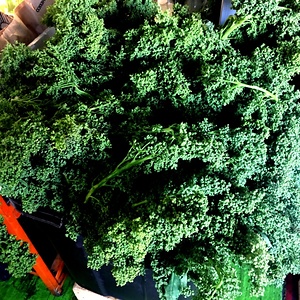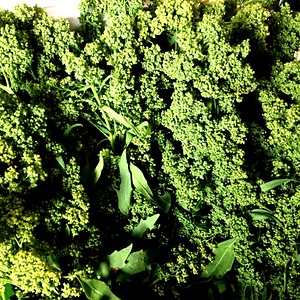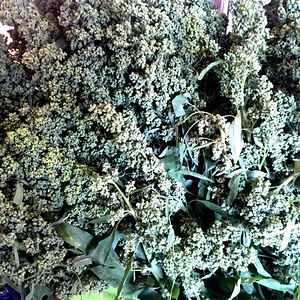


Huauzontles
Estimated Inventory, lb : 0
Description/Taste
Huauzontle is a bush-like plant with a thick and fibrous main stem protected by many long and slender branches. The branches grow upright and are covered in small oval leaves. When young, the plant is green, but as it matures, it will develop a red tint, eventually displaying bright red hues in the fall. Huauzontle also produces small florets on the end of the branches in the spring through summer. The unopened green buds have an appearance similar to baby broccoli buds and contain a delicate, tender, and subtly crunchy consistency. If the flowers are allowed to mature, they will eventually develop small and round seeds. One of the most noticeable features of the herb is its sharp, herbaceous, and astringent aroma. Huauzontle is a unique herb as the young leaves, stems, unopened flower buds, and seeds are edible. When consumed, Huauzontle has a vegetal, robust green flavor mixed with peppery and minty nuances and a faintly bitter minerality.
Seasons/Availability
Huauzontle flowers and produces new growth in the spring through early fall. In the late summer through fall, the plants will also develop seeds that can be dried for extended use.
Current Facts
Huauzontle, botanically classified as Chenopodium nuttalliae, is a wild Mexican herb belonging to the Amaranthaceae family along with quinoa, amaranth, and lamb’s quarters. The bushy plant can reach up to one meter in height and has been used since pre-Hispanic times in cultural, herbal, and culinary practices. The name Huauzontle is derived from the Nahuatl word nuahutzontli, meaning “hairy amaranth,” and is a fast-growing plant favored for its low maintenance, hardiness, and high yields. Huauzontle is also known as Huazontle, Cuazontle, Aztec Broccoli, Huauthili, and Red Aztec Spinach and is a type of quelite or wild green commonly eaten throughout Mexico. The stems, leaves, flower buds, and seeds are edible and are valued among locals for their high nutritional properties. In the modern-day, Huauzontle is a rare herb that is challenging to find outside of local markets in Mexico and the United States, and the flower buds are the preferred portion of the plant, consumed as a lightly cooked side dish or battered and fried as a robust entrée.
Nutritional Value
Huauzontle is an excellent source of calcium and phosphorus to strengthen bones and teeth, fiber to stimulate the digestive tract, and vitamins A and C to boost the immune system and reduce inflammation. The herb also contains potassium to balance fluid levels within the body and provides lower amounts of iron and vitamin E. It is important to note that Huauzontle also has small amounts of saponins, which are natural compounds that give the plant a slightly bitter taste. Saponins are also found in grains like quinoa and can be toxic when consumed in large amounts, but Huauzontle contains low quantities of the compound.
Applications
Huauzontle is a versatile plant as the young leaves, stems, unopened flowers, and seeds are edible. The young leaves and stems should be harvested when they are still immature, tender, and green. The leaves can be incorporated raw into salads, but many chefs prefer to lightly blanch to help remove saponins. Huauzontle leaves can also be mixed in pesto, sauteed with onion and garlic, or stirred into soups and stews. In addition to the stems and leaves, the unopened flower buds maintain a tender, subtle crunch when cooked, and they can be prepared whole or removed from the stem for fried, steamed, stir-fried, or blanched preparations. When cooked whole, the flower buds are typically battered, stuffed with cheese, fried, and coated in a flavorful tomato sauce. The buds are eaten straight off the stems, and the stems are discarded as they typically have a bitter flavor. Huauzontle flower buds can also be removed from the stems before cooking and sauteed or stir-fried with aromatics as a simple side dish, cooked with eggs, formed into patties and fried, sprinkled over pizza, or used as a topping over tacos, soups, and pasta. Beyond the flower buds, Huauzontle seeds can be harvested and dried, used to make tortillas, ground into flour, or cooked similarly to quinoa. Huauzontle pairs well with salty cheeses, chile peppers, including pasilla, serrano, or chipotle, vinegar, citrus, tomatoes, and legumes. Fresh Huauzontle leaves, flower buds, and stems should be used immediately after harvesting the best quality and flavor. Dried seeds will keep 1 to 3 years when stored in a cool, dry, and dark place.
Ethnic/Cultural Info
Huauzontle is a traditional ingredient used in meals during the season of Lent in Mexico. Lent, also known as Cuaresma, is a Catholic practice of penitence during the 40 days before Easter Sunday. It is a time for Catholics to abstain from specific luxuries to increase their faith, and every Friday, meals must not contain meat to practice self-discipline. With an increase of vegetarian meals, many Mexican families cook nostalgic recipes that have been passed between familial generations during the Lent season. Huauzontle is a cherished seasonal ingredient and is most famously prepared in tortitas de Huauzontle, a dish where the plant's buds and stems are boiled, drained, battered, and fried, covered in cheese, and then bathed in a cream-based or tomato sauce. The fried patties can also be covered in various kinds of sauces ranging from green salsa to a spicy chile sauce, and the meal offers vital nutrients in a flavorful, creative, and inexpensive preparation. Huauzontle is also in season during Lent, and the unopened flower buds are at peak freshness, encouraging locals to eat seasonally. The small green flower buds are typically sold in a tianguis, an open-air market featuring local growers, merchants, and food vendors. These grassroots markets contain some of the freshest produce in Mexico, as the vendors range from farmers to residents selling items from their home gardens. The markets are also considered an honored cultural tradition, with origins dating to pre-Hispanic times. Many of the items sold in the markets, including Huauzontle, reflect the market’s ancient roots.
Geography/History
Huauzontle is a pre-Hispanic herb native to Mexico, where it has been growing wild for thousands of years. The bushy plant was used in culinary, cultural, and religious practices during the Aztec Empire and was one of the most important crops during the reign of Moctezuma II. Huauzontle was also accepted as a tax tribute in the Aztec Empire, and one record documented that over 160,000 bushels of the herb were collected as payments in a single year. Beyond Mexico, Huauzontle was also introduced further north and was brought to the Southern Appalachian tribes through migrating peoples and trade. When the Spanish arrived in Mexico, the use of Huauzontle was banned primarily due to its involvement in rituals for human sacrifice. The once common herb was deeply suppressed, removed from local markets and fields, and essentially remained hidden until the late 20th century. Despite its disappearance, Huauzontle was preserved through home gardens and heritage growers and was slowly reintroduced to commercial markets in the late 20th and early 21st centuries. Today Huauzontle can be found through farmer’s markets, specialty grocers, and online retailers in Mexico, the United States, and Canada. Within Mexico, the herb is primarily cultivated in Puebla, Tlaxcala, and Guerrero.
Recipe Ideas
Recipes that include Huauzontles. One
| Gourmet Sleuth |
|
Huauzontle con Cebollas y Comino |
| Mexican Food and More |
|
Huauzontles Croquettes |
| Mexico in My Kitchen |
|
Huauzontle Patties |







